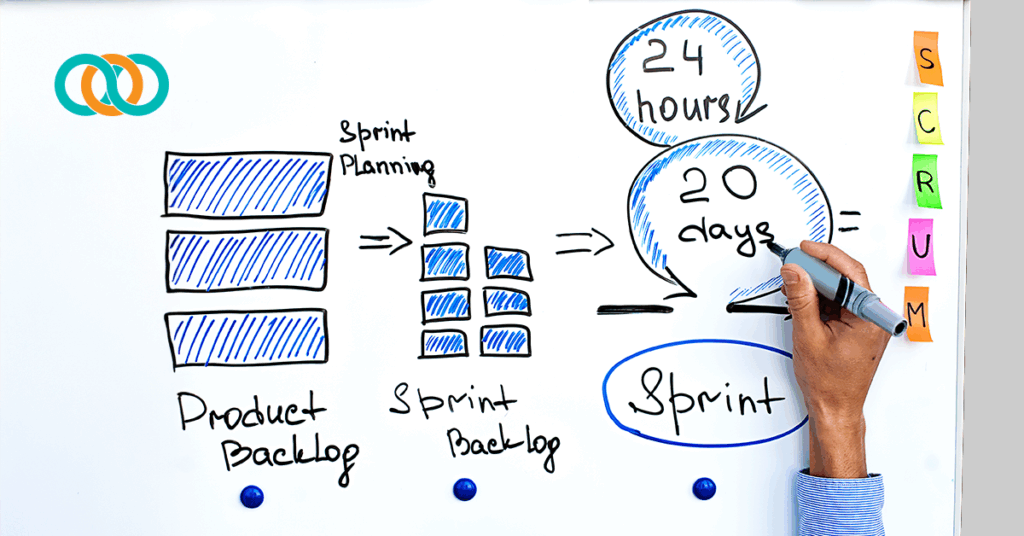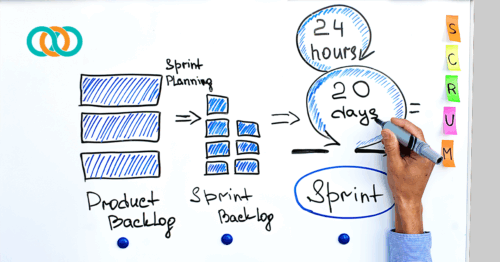Why Instructional Design Consultants Use Agile Methods
Priorities shift. It’s inevitable. But shifting priorities shouldn’t mean lost progress.
Imagine this: your instructional design team is knee-deep in a corporate training project. The storyboard is halfway drafted, video scripts are in development, eLearning developers are heads-down in course builds, and graphic designers are polishing custom visuals to bring it all together. Everyone is in flow when, suddenly, leadership announces a new corporate initiative with higher priority.
The project grinds to a halt. Files get saved in a shared drive under a “pick up later” folder. The intention is good: we’ll pick this back up where we left off.
But “later” often means weeks or even months. And when the team finally circles back, the momentum is gone. Energy is lost to reorienting:
- What was the big purpose of this training initiative?
- What design approach had we committed to?
- Which stakeholder preferences were already addressed, and which were still open?
- Where exactly did each eLearning module, storyboard, or facilitator guide leave off?
In fast-moving organizations, this cycle happens often. L&D projects pause midstream as new business goals take center stage, and when they restart, learning and development teams spend hours retracing steps and piecing together the bigger picture.
That’s why instructional design consultants often bring Agile practices into corporate training projects. Agile isn’t about chaotic pivots or constant mid-sprint changes. They’re about building flexibility into your instructional design process so work moves forward smoothly, even when priorities shift.
The Tension Between ADDIE and Agile
Most training teams know and trust ADDIE (Analysis, Design, Development, Implementation, Evaluation). It’s the industry standard. But in practice, ADDIE can feel like a waterfall: one phase must be complete before the next begins.
That structure works well for Analysis and Design, where upfront clarity is essential. But the Development stage is where many projects get stuck. It’s often long, complex, and vulnerable to shifting business priorities.
That’s why many organizations bring in instructional design consultants who apply Agile practices inside the ADDIE model. The result? You get the stability of ADDIE with the adaptability of Agile.
Applying Agile Inside ADDIE
1. Analysis: Anchor the Project with a High-Level Plan
In the Analysis stage, clarity prevents rework. Without it, teams waste time re-analyzing every time a project pauses. Instructional design consultants recommend creating a high-level design plan that documents:
- The business goals and success measures.
- Learner needs and audience priorities.
- Dependencies such as SME availability and stakeholder checkpoints.
This plan becomes the anchor. No matter when the team picks the project back up, everyone knows the “why” and the “what’s next.”
2. Design: Build Repeatable Processes into Sprints
In ADDIE, the Design phase traditionally produces the learning blueprint; objectives, assessments, sequencing, and delivery strategies. It often includes detailed storyboards and facilitator guides.
Instructional design consultants make this step more Agile by designing repeatable, sprint-friendly design processes. They build checkpoints that allow forward progress in smaller chunks:
- Each storyboard follows a draft → SME review → revision cycle, kept within a sprint.
- Engagement strategies (quizzes, simulations, discussions) are defined upfront so they aren’t skipped under deadline pressure.
- Reusable templates streamline design across modules and ensure consistency for learners.
This approach respects ADDIE’s structure while making Design more adaptive, ensuring the team can move quickly without losing alignment.
3. Development: Match Sprints to Business Needs
The Development phase is where deliverables come to life; eLearning modules, leader guides, videos, and job aids. Traditionally, these builds would be completed sequentially, with review only at the end.
Agile reframes Development as iterative:
- Weekly sprints for high-priority projects that require fast pivots.
- Biweekly sprints for steady, moderate-risk initiatives.
- Monthly sprints for low-risk maintenance work.
Every sprint should include a feedback/review cycle for the assets built in that timeframe. For example, if one module is developed in a sprint, it receives one review cycle to catch errors or nuances missed during earlier phases. These reviews are critical for quality but are not the same as program evaluation. They’re checkpoints to keep the build on track.
This approach is critical because it allows stakeholders and instructional design consultants to:
- Catch outdated or inaccurate information before the entire build is complete.
- Validate that activities and assessments align with learning objectives.
- Identify technical issues (LMS compatibility, accessibility gaps, or navigation problems) early.
- Build stakeholder confidence by showing visible progress tied to business goals.
To keep teams focused, learning and development consultants protect the sprint by placing new requests into a backlog for later prioritization. Agile ceremonies (like sprint planning, standups, reviews, and retrospectives) provide structure, communication, and opportunities to surface risks before they derail the project.
4. Implementation: Flex Small Before Scaling Big
In ADDIE, Implementation means launching the program to learners. Traditionally, this is a single rollout. For larger projects, Agile encourages breaking Implementation into smaller, lower-risk launches to reduce risk and validate effectiveness before scaling.
For example:
- Pilot a single module or tier before launching the full curriculum.
- Roll out to one business unit before scaling company-wide.
- Use pilot feedback to refine upcoming modules or delivery strategies.
This is especially valuable in multi-tier or multi-module programs, where each launch can inform the next build. By structuring Implementation in cycles, instructional design consultants help organizations catch outdated content, identify learner challenges, and adapt before committing to a full-scale rollout.
5. Evaluation: Continuous, Not Afterthought
ADDIE places Evaluation at the end, and this remains true even in Agile-informed approaches. Evaluation is not the same as development feedback loops. It’s about measuring program effectiveness once learners have experienced it.
Agile consultants strengthen this phase by:
- Aligning evaluation with the business goals identified during Analysis.
- Using pilot results and early rollouts to measure impact before full deployment.
- Collecting learner feedback, performance metrics, and manager observations to assess effectiveness.
While feedback loops during Design and Development keep the build accurate, Evaluation measures whether the training delivered the desired business outcomes. This distinction ensures projects don’t become “never-ending” cycles. Training projects do end, but with Agile practices, they end with clearer data and a stronger impact.
Agile Practices That Translate to L&D
Many core Agile practices adapt beautifully to L&D:
- Daily Standups – 15-minute check-ins to align, share blockers, and move fast.
- Sprints – Short, time-boxed cycles that encourage quick feedback loops.
- Sprint Planning – Clear priorities and ownership before each sprint starts.
- Retrospectives – Reflect on what worked, what didn’t, and how to improve.
- Kanban Boards – Visual workflows to track progress and avoid bottlenecks.
- Backlog Grooming – Regularly update and prioritize the “to-do list” of training needs.
The key? Agile isn’t one-size-fits-all. It’s about adapting these practices to fit your workflow, your team, and your business context.
Why It Works
By building flexibility into the process:
- Teams can pause and restart projects without losing alignment.
- Designers work to their strengths, improving both speed and quality.
- Stakeholders see consistent progress tied to business outcomes, not just busywork.
The result? A high-quality program delivered on time, with a team that trusts the process and supports one another through shifting priorities.
Final Thoughts
Shifting priorities are inevitable. Losing momentum doesn’t have to be. By borrowing from Agile methodologies and adapting it to learning and development, organizations can move faster, collaborate better, and keep progress on track; no matter how quickly business needs change.
Artificial intelligence is changing the way learning gets designed and delivered but the real impact doesn’t come from automation alone. It comes from thoughtful design, clear oversight, and leaders who know how to use insights to build trust and growth. If your team is exploring how to integrate Agile practices into learning design, TrainingPros can connect you with experienced instructional design consultants, eLearning developers, and corporate training consultants who know how to balance innovation with human judgment.
Download Your Copy of Trends in Learning & Development: Insights from Learning Leaders
Ready to Work with Us?
At TrainingPros, we connect organizations with experienced instructional designers, eLearning developers, facilitators, and training consultants. Whether you’re scaling onboarding, launching new systems, or expanding leadership development, we help you shift from reactive to results-driven.
We’ve been named a Top 20 Staffing Company by Training Industry, a Smartchoice® Preferred Provider by Brandon Hall Group, and a Champion of Learning by ATD–honors that reflect our commitment to providing top-tier, problem-solving talent.
When you have more projects than people™, TrainingPros can provide the right L&D consultant to start your project with confidence.
- 1share
- LinkedIn0
- Twitter0
- Facebook0
- Love This1











